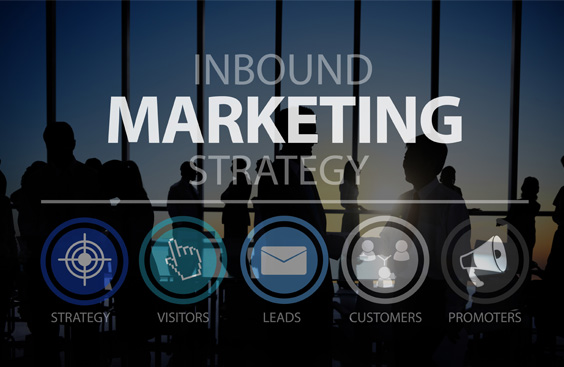How to use Inbound Marketing to attract customers

Today, we at Made will explain how to use Inbound Marketing to attract customers.
First of all, inbound marketing, also known as Inbound Marketing, was first formally introduced by Brian Halligan and Dharmesh Shah, founders of Hubspot.
Inbound marketing is based on the idea that modern consumers
have become immune to traditional marketing methods.
This is why instead of interrupting people’s lives with unsolicited advertising messages, inbound marketing focuses on providing useful and interesting content that attracts people to the company.
In fact, the goal is to create long-term relationships with customers through the provision of useful and relevant content that responds to their needs and questions.
The 4 phases of Inbound Marketing
There are four main phases of Inbound Marketing:
Attract
The first phase is to attract visitors to your website through quality content, social media, SEO and email marketing campaigns.
Quality content includes blogs, infographics, videos and other types of content that address the questions and concerns of potential customers.
Convert
Once you have attracted visitors to your website, the next step is to convert website visitors into leads, i.e. people interested in the products or services offered by your company.
In this phase, the goal is to provide valuable content that addresses the questions and needs of potential customers in order to convert them into qualified leads.
Examples of techniques used in this phase may include:
Quality content creation: Informative and valuable content, such as blog posts, guides, webinars and ebooks, attracts potential customers to the website and helps them better understand the products or services offered by the company.
Landing Page: A landing page is a specific page on the website designed to convert visitors into leads. It usually includes a contact form or call-to-action button to encourage visitors to provide their contact details in exchange for valuable content such as guides or webinars.
Contact form: A contact form is a form that allows visitors to provide their contact details to receive further information about the company’s products or services.
Marketing automation: Marketing automation allows the automation of lead conversion processes, such as sending follow-up emails and segmenting leads based on their actions on the website.
Call-to-action: Call-to-actions are buttons or links that encourage visitors to take an action, such as subscribing to a newsletter or downloading an ebook.
Close
The third stage of Inbound Marketing is to close the sale.
Once you have collected contact information on leads, you can start nurturing them with targeted content and information about your products or services.
Using the information collected on leads, you can customise your communications and create a personalised buying experience.
There are several ways to close a sale at this stage, some examples might be:
Offering a personalised follow-up call: in this case, you can contact the potential customer to offer a personal call to answer any questions and help them make a decision.
Using a contact or quote request form: this method allows the potential customer to request more information or request a quote.
Creating a special or time-limited offer: this can create a sense of urgency and push the potential customer to make a decision faster.
Use a conversion landing page: a conversion landing page is a web page designed to convert visitors into customers; it is a specific page created for a marketing campaign or a specific offer.
Use retargeting: retargeting consists of showing advertisements to people who have already visited your website.
These are just a few examples of how to close a sale in the ‘close’ phase of inbound marketing.
The important thing is that the chosen approach is customised and tailored to the potential customer, so as to increase the chances of conversion.
Loyalty: The last stage of Inbound Marketing is to retain existing customers. Once you have closed a sale, it is important to continue providing value to your customers.
This can be done through various means, including:
Quality content creation: provide useful and interesting information to your customers, through blogs, videos, webinars, e-books, etc.
Personalising the user experience: using the data collected on customers to offer them a personalised and relevant experience.
For example, recommending products or services based on their interests and preferences.
Loyalty programmes: reward loyal customers with discounts, exclusive offers and other incentives to encourage them to continue shopping.
Customer service: provide efficient and friendly support to customers to solve any problems or questions they may have.
Feedback and evaluations: asking customers to provide feedback and evaluations on products and services offered, so that we can continuously improve our offering and meet customer needs.
Examples of companies that effectively use this stage of inbound marketing are Amazon, which offers a loyalty programme (Prime) and recommends products based on customers’ purchase history, or Zappos, which stands out for exceptional customer service.
What are the advantages of Inbound Marketing
Inbound Marketing offers a number of advantages over traditional marketing methodologies:
Greater Effectiveness
Inbound Marketing focuses on attracting potential customers to the company instead of intercepting them. This means that advertising messages are more targeted and therefore more effective.
Lower Cost
Inbound marketing focuses on using digital methods to attract customers, such as content marketing and SEO. This means that costs are generally lower than traditional methods, such as TV or newspaper advertising.
Greater Customer Engagement
Inbound marketing focuses on delivering valuable content to customers, which means customers are more engaged and more likely to become loyal customers.
More Transparency
Inbound marketing focuses on being honest and transparent with customers, which means customers are more likely to trust the company and become loyal customers.
Increased measurability
Inbound Marketing focuses on using digital technologies to track campaign progress and measure results. This means that it is possible to gain greater transparency on the effectiveness of campaigns and adapt strategies based on the data obtained.
More Scalability
Inbound marketing is based on the use of digital technologies and the creation of quality content, which means you can reach a global audience.
Greater ability to generate leads
Inbound marketing focuses on attracting potential customers to the company through the provision of valuable content, which means there is a greater chance of generating qualified leads.
Higher chance of conversion
Because it focuses on attracting only interested prospects, there is a greater chance that these leads will convert into actual customers.
Higher chance of generating referrals
As Inbound Marketing focuses on providing a positive customer experience, there is therefore a greater chance that these customers will recommend the company to friends and family.
How to do Inbound Marketing
Doing Inbound Marketing requires a combination of techniques and strategies, including:
Content Marketing: Creating and sharing valuable content, such as blog posts, e-books, infographics and videos, that attracts

the attention of potential customers and help them solve their problems and satisfy their needs.
SEO: Optimise content for search engines so that potential customers can find it easily.
Marketing Automation: Use software to automate repetitive marketing tasks, such as sending e-mails or generating leads.
Data Analysis: Track campaign progress and measure results to gain greater transparency on campaign effectiveness. Adapt strategies based on the data obtained.
Social Media Marketing: Use social media to share content and interact with potential customers.
Attraction Marketing: Use non-intrusive marketing techniques such as content marketing and permission marketing to attract the attention of potential customers in a natural and non-intrusive way.
Lead nurturing: Use lead nurturing techniques to build long-term relationships with potential customers and convert them into actual customers.
Retention: Use retention techniques to build long-term relationships with existing customers and generate referrals.
Measuring results in Inbound Marketing
Measuring results is an important part of Inbound Marketing as it allows you to assess the effectiveness of campaigns and adjust strategies based on the data obtained.
Here are some of the most common metrics used to measure inbound marketing results:
Website Traffic: This metric measures the number of website visitors and can be used to evaluate the effectiveness of attraction campaigns.
Conversion Rate: This metric measures the percentage of website visitors who take a desired action. Such as filling out a contact form or purchasing a product, and can be used to evaluate the effectiveness of conversion campaigns.
Closing Rate: This metric measures the percentage of leads that convert into actual customers and can be used to evaluate the effectiveness of closing campaigns.
Retention: This metric measures the percentage of customers who return to make purchases and can be used to evaluate the effectiveness of retention campaigns.
ROI: This metric measures return on investment and can be used to evaluate the effectiveness of campaigns in terms of profits generated versus costs incurred.
Value per Lead: This metric measures how valuable a lead is to the company and can be used to assess the effectiveness of lead generation campaigns.
Referral: This metric measures how many customers have recommended the company to friends and family and can be used to assess the effectiveness of referral campaigns.
Life Time Value: Measures the total economic value generated by a customer over time. It can be used to assess the effectiveness of loyalty campaigns and the profitability of long-term customer relationships.
Bounce rate: Measures the percentage of website visitors who leave the site after viewing only one page and can be used to assess the quality and attractiveness of website content.
Engagement: This metric measures the degree to which website visitors engage with the content and can be used to assess the attractiveness and effectiveness of the website content.
To gain a complete understanding of the effectiveness of inbound marketing campaigns, it is important to use a combination of these and other metrics to gain an overview of the results.
Furthermore, it is important to use data analysis software to efficiently collect and analyse data and make any adjustments to campaigns based on the results obtained.

How to use Inbound Marketing to attract customers in different economic sectors
Inbound marketing can be used effectively in different economic sectors to attract, convert, close and retain customers.
Here are some examples of how inbound marketing can be used in different sectors:
E-commerce: An e-commerce company can use inbound marketing to create informative product content. Such as buying guides and product reviews to attract the attention of potential customers and help them make purchasing decisions. In addition, the use of marketing automation techniques can help the company send personalised follow-up e-mails to leads to convert them into actual customers.
Financial services: A financial services company can use inbound marketing to create informative content on various topics. Such as financial planning and investments, to attract the attention of potential customers and generate qualified leads. In addition, the use of lead nurturing techniques can help the company build long-term relationships with leads and convert them into actual customers.
Technology: A technology company can use inbound marketing to create informative content on topics such as the latest technology. Also how best to use products to attract the attention of potential customers and generate qualified leads. In addition, using social media can help create a community of loyal customers who share the company’s content and promote its products.
Inbound marketing can also be used to create webinars, guides, whitepapers and other educational content to help customers better understand the products and how to use them.
In this way, the company can generate qualified leads and increase sales opportunities.
Winning Inbound Marketing Examples
Mc Donald’s
One of the largest fast food chains in the world, has successfully used Inbound Marketing to attract customers and build long-term relationships with them.
An example of this is their digital marketing campaign ‘Our Food. Your Questions.’, which they launched in 2012.
The campaign encouraged customers to ask questions about the quality of the ingredients used in their products. It provided transparent and detailed answers through a dedicated website and social channels.
This helped to reassure customers concerned about the quality of the ingredients used by McDonald’s and build a relationship of trust with them.
In addition, McDonald’s also used social media to create interesting and engaging content for their followers.
Such as video tutorials on how to prepare their famous burgers at home or sweepstakes for their most loyal fans.
This content caught the attention of customers and encouraged them to interact with the brand, creating long-term relationships.
McLaren
McLaren is a luxury car and advanced technology company that has successfully used Inbound Marketing to attract and retain their customers.
Here are some examples of how they have used Inbound Marketing:
1)Creating valuable content: McLaren created a blog where they publish articles and videos on topics related to their cars, technology and company history. This content helps potential customers learn more about the company and its products, creating interest and trust.
2)Using Social Media: McLaren uses their social profiles to share interesting and engaging content. Such as pictures and videos of their cars in action, news and updates on events and company news. This helps to create a community of McLaren fans and maintain an ongoing relationship with customers.
3)Loyalty programmes and special offers: McLaren offers loyalty programmes for its customers. Such as the opportunity to participate in exclusive events and test drives. In addition, it also offers special offers to customers who sign up for their loyalty programme, thus incentivising repeat purchases.
4)Personalisation of the buying experience: McLaren offers its customers the possibility to personalise their car according to their needs and preferences.
Thus creating a unique and personalised buying experience.
This can include the choice of colours, interiors, accessories and customisation options for the engine and performance. This strategy helps to build customer loyalty and differentiate from the competition.
American Express
American Express uses a variety of inbound marketing techniques to attract potential and retain existing customers.
For example, offering information and financial education through their website and social channels.
They also create loyalty programmes to reward loyal customers, and use automated marketing to send personalised messages to customers based on their preferences and purchasing behaviour.
In general, American Express uses a combination of useful content, loyalty programmes and automated marketing to attract and retain customers through inbound marketing.
Sorgenia
Sorgenia is an Italian company that provides electricity and natural gas to individuals and businesses.
This company uses a variety of Inbound Marketing techniques to attract potential customers and retain existing ones.
For example, it uses a blog to provide useful information on renewable energy.
Not only that, but also on how to make the best use of electricity and natural gas.
Use social media to build relationships with customers and provide them with exclusive information and offers. It also uses automated marketing to create a personalised customer experience. Send them personalised messages based on their preferences and purchasing behaviour.
How to use Inbound Marketing to attract customers: Conclusions
In conclusion, Inbound Marketing is an effective marketing strategy to attract and retain customers through useful and interesting content.
American Express, Sorgenia, McLaren and McDonald’s are examples of companies that successfully use Inbound Marketing to reach their customers and provide them with a unique and personalised shopping experience.
Don’t miss the opportunity to keep up with the latest trends and techniques in digital marketing.
Keep reading our blog to find out how to get the most out of your marketing!

